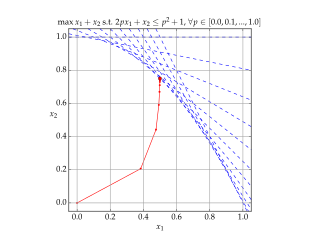
In geometry, a simplex is a generalization of the notion of a triangle or tetrahedron to arbitrary dimensions.

Linear programming is a method to achieve the best outcome in a mathematical model whose requirements are represented by linear relationships. Linear programming is a special case of mathematical programming.

Mathematical optimization or mathematical programming is the selection of a best element from some set of available alternatives. Optimization problems of sorts arise in all quantitative disciplines from computer science and engineering to operations research and economics, and the development of solution methods has been of interest in mathematics for centuries.
Kruskal's algorithm is a minimum-spanning-tree algorithm which finds an edge of the least possible weight that connects any two trees in the forest. It is a greedy algorithm in graph theory as it finds a minimum spanning tree for a connected weighted graph adding increasing cost arcs at each step. This means it finds a subset of the edges that forms a tree that includes every vertex, where the total weight of all the edges in the tree is minimized. If the graph is not connected, then it finds a minimum spanning forest.
In mathematical optimization, Dantzig's simplex algorithm is a popular algorithm for linear programming.
In mathematical optimization theory, the linear complementarity problem (LCP) arises frequently in computational mechanics and encompasses the well-known quadratic programming as a special case. It was proposed by Cottle and Dantzig in 1968.

Interior-point methods are a certain class of algorithms that solve linear and nonlinear convex optimization problems.

The Nelder–Mead method is a commonly applied numerical method used to find the minimum or maximum of an objective function in a multidimensional space. It is a direct search method and is often applied to nonlinear optimization problems for which derivatives may not be known. However, the Nelder–Mead technique is a heuristic search method that can converge to non-stationary points on problems that can be solved by alternative methods.
The minimum-cost flow problem (MCFP) is an optimization and decision problem to find the cheapest possible way of sending a certain amount of flow through a flow network. A typical application of this problem involves finding the best delivery route from a factory to a warehouse where the road network has some capacity and cost associated. The minimum cost flow problem is one of the most fundamental among all flow and circulation problems because most other such problems can be cast as a minimum cost flow problem and also that it can be solved efficiently using the network simplex algorithm.
The pivot or pivot element is the element of a matrix, or an array, which is selected first by an algorithm, to do certain calculations. In the case of matrix algorithms, a pivot entry is usually required to be at least distinct from zero, and often distant from it; in this case finding this element is called pivoting. Pivoting may be followed by an interchange of rows or columns to bring the pivot to a fixed position and allow the algorithm to proceed successfully, and possibly to reduce round-off error. It is often used for verifying row echelon form.
In mathematical optimization, Bland's rule is an algorithmic refinement of the simplex method for linear optimization.
In linear programming, reduced cost, or opportunity cost, is the amount by which an objective function coefficient would have to improve before it would be possible for a corresponding variable to assume a positive value in the optimal solution. It is the cost for increasing a variable by a small amount, i.e., the first derivative from a certain point on the polyhedron that constrains the problem. When the point is a vertex in the polyhedron, the variable with the most extreme cost, negatively for minimization and positively maximization, is sometimes referred to as the steepest edge.

In theoretical computer science, smoothed analysis is a way of measuring the complexity of an algorithm. Since its introduction in 2001, smoothed analysis has been used as a basis for considerable research, for problems ranging from mathematical programming, numerical analysis, machine learning, and data mining. It can give a more realistic analysis of the practical performance of the algorithm, such as its running time, than using worst-case or average-case scenarios.

In mathematical optimization, the criss-cross algorithm is any of a family of algorithms for linear programming. Variants of the criss-cross algorithm also solve more general problems with linear inequality constraints and nonlinear objective functions; there are criss-cross algorithms for linear-fractional programming problems, quadratic-programming problems, and linear complementarity problems.

The Klee–Minty cube or Klee–Minty polytope is a unit hypercube of variable dimension whose corners have been perturbed. Klee and Minty demonstrated that George Dantzig's simplex algorithm has poor worst-case performance when initialized at one corner of their "squashed cube". On the three-dimensional version, the simplex algorithm and the criss-cross algorithm visit all 8 corners in the worst case.
In mathematical optimization, the revised simplex method is a variant of George Dantzig's simplex method for linear programming.
In mathematical optimization, the network simplex algorithm is a graph theoretic specialization of the simplex algorithm. The algorithm is usually formulated in terms of a minimum-cost flow problem and can be efficiently solved in polynomial time. The network simplex method works very well in practice, typically 200 to 300 times faster than the simplex method applied to general linear program of same dimensions.
In mathematical optimization, Zadeh's rule is an algorithmic refinement of the simplex method for linear optimization.
In mathematical optimization, Cunningham's rule is an algorithmic refinement of the simplex method for linear optimization.
Donald Goldfarb is an American mathematician, best known for his works in mathematical optimization and numerical analysis.






